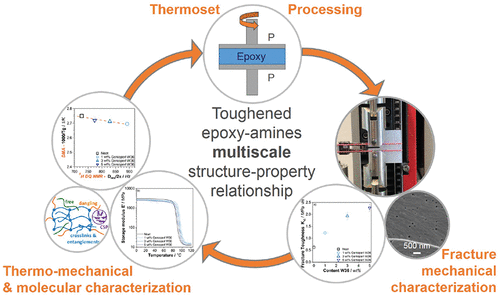当前位置:
X-MOL 学术
›
ACS Appl. Polym. Mater.
›
论文详情
Our official English website, www.x-mol.net, welcomes your feedback! (Note: you will need to create a separate account there.)
Time Domain 1H NMR, Thermomechanical, and Rheology Multiscale Structural Characterization of Polydimethylsiloxane-Toughened Epoxy Nanocomposites for Liquid Composite Molding
ACS Applied Polymer Materials ( IF 5 ) Pub Date : 2020-08-31 , DOI: 10.1021/acsapm.0c00763 Fabian Hübner 1 , Eduardo Szpoganicz 1 , Martin Demleitner 1 , Justus Kuhnigk 1 , Volker Altstädt 1 , Agustín Rios de Anda 2
ACS Applied Polymer Materials ( IF 5 ) Pub Date : 2020-08-31 , DOI: 10.1021/acsapm.0c00763 Fabian Hübner 1 , Eduardo Szpoganicz 1 , Martin Demleitner 1 , Justus Kuhnigk 1 , Volker Altstädt 1 , Agustín Rios de Anda 2
Affiliation

|
In this study, an applicative-oriented epoxy–amine thermoset was toughened with 1, 3, and 5 wt % of polydimethylsiloxane (PDMS) core–shell-particles (CSP), and the influence of the materials morphology on their functional mechanical properties was investigated for the first time by a multiscale experimental approach. First, rheological measurements showed faster gel behavior in matrices containing PDMS-CSP. Then, 1 wt % PDMS-CSP increased the fracture toughness KIC by more than 100%, as well as giving an increase on the glass transition temperature (Tg) from 90 to 98 °C and Young’s modulus E by 15%. More interestingly, the increase in Tg and E is nonlinear with PDMS-CSP content, with the highest values observed for 1 wt % toughener. DMTA and time domain NMR measurements showed that the matrices cross-link density and network degree of homogeneity do not depend linearly with PDMS-CSP content, and they follow the same trend as for Tg and E. By associating both techniques, a linear relationship was obtained between the network structure probed by NMR and the thermomechanical behavior by DMTA, meaning that the macroscopic properties depend additionally on the network morphology. Finally, by combining all of the aforementioned techniques through a multiscale approach, it was shown that PDMS-CSP acts as a cross-link nucleating agent for the epoxy–amine matrix, inducing higher cross-link densities, thus yielding higher functional mechanical properties. Such an unprecedented synergetic experimental approach associated with a multiscale nanoparticle interaction and monomer cross-linking provides an original and robust manner to determine and deepen the understanding of key structure–macroscopic property relationships for applicative-oriented epoxy thermosets.
中文翻译:

用于液体复合材料成型的聚二甲基硅氧烷增韧环氧纳米复合材料的时域1 H NMR,热力学和流变学多尺度结构表征
在本研究中,以1、3和5 wt%的聚二甲基硅氧烷(PDMS)核-壳颗粒(CSP)增韧了应用导向的环氧-胺热固性,材料形态对其功能机械性能的影响为通过多尺度实验方法首次进行了调查。首先,流变学测量表明在含有PDMS-CSP的基质中凝胶行为更快。然后,1重量%的PDMS-CSP使断裂韧性K IC增加超过100%,并且使玻璃化转变温度(T g)从90℃增加到98℃,并且杨氏模量E增加15%。更有趣的是,T g和E的增加与PDMS-CSP含量呈非线性关系,在1 wt%增韧剂中观察到最高值。DMTA和时域NMR测量表明,基质的交联密度和网络均匀度与PDMS-CSP含量不线性相关,并且它们遵循与T g和E相同的趋势。通过结合这两种技术,通过NMR探测的网络结构与通过DMTA的热机械行为之间获得了线性关系,这意味着宏观性质还取决于网络形态。最后,通过多尺度方法将所有上述技术结合起来,结果表明PDMS-CSP充当环氧-胺基体的交联成核剂,诱导更高的交联密度,从而产生更高的功能机械性能。这种与多尺度纳米粒子相互作用和单体交联相关的前所未有的协同实验方法,为确定和加深对面向应用的环氧热固性材料的关键结构-宏观性能关系提供了一种新颖而强大的方法。
更新日期:2020-08-31
中文翻译:

用于液体复合材料成型的聚二甲基硅氧烷增韧环氧纳米复合材料的时域1 H NMR,热力学和流变学多尺度结构表征
在本研究中,以1、3和5 wt%的聚二甲基硅氧烷(PDMS)核-壳颗粒(CSP)增韧了应用导向的环氧-胺热固性,材料形态对其功能机械性能的影响为通过多尺度实验方法首次进行了调查。首先,流变学测量表明在含有PDMS-CSP的基质中凝胶行为更快。然后,1重量%的PDMS-CSP使断裂韧性K IC增加超过100%,并且使玻璃化转变温度(T g)从90℃增加到98℃,并且杨氏模量E增加15%。更有趣的是,T g和E的增加与PDMS-CSP含量呈非线性关系,在1 wt%增韧剂中观察到最高值。DMTA和时域NMR测量表明,基质的交联密度和网络均匀度与PDMS-CSP含量不线性相关,并且它们遵循与T g和E相同的趋势。通过结合这两种技术,通过NMR探测的网络结构与通过DMTA的热机械行为之间获得了线性关系,这意味着宏观性质还取决于网络形态。最后,通过多尺度方法将所有上述技术结合起来,结果表明PDMS-CSP充当环氧-胺基体的交联成核剂,诱导更高的交联密度,从而产生更高的功能机械性能。这种与多尺度纳米粒子相互作用和单体交联相关的前所未有的协同实验方法,为确定和加深对面向应用的环氧热固性材料的关键结构-宏观性能关系提供了一种新颖而强大的方法。


























 京公网安备 11010802027423号
京公网安备 11010802027423号